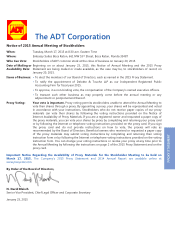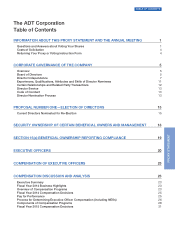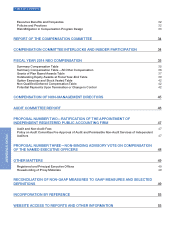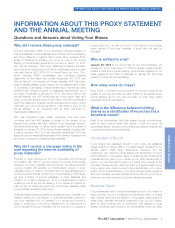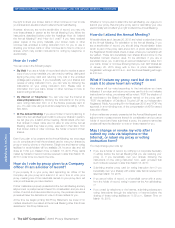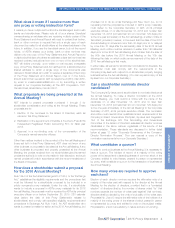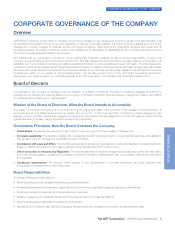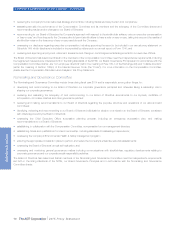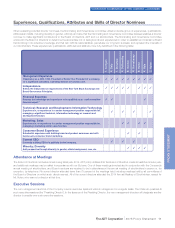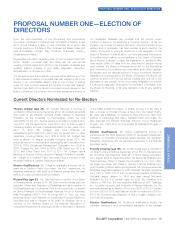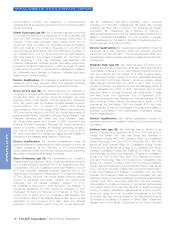ADT 2014 Annual Report Download - page 14
Download and view the complete annual report
Please find page 14 of the 2014 ADT annual report below. You can navigate through the pages in the report by either clicking on the pages listed below, or by using the keyword search tool below to find specific information within the annual report.
CORPORATE GOVERNANCE OF THE COMPANY—CONTINUED
•Selecting, monitoring, evaluating, compensating, and if necessary replacing the Chief Executive Officer and other senior executives, and
seeing that management development and succession plans are maintained for these executive positions.
•Determining the Chief Executive Officer’s compensation, and approving senior executives’ compensation, based on performance in meeting
pre-determined standards and objectives.
•Determining that procedures are in place and designed to promote compliance with laws and regulations and setting an ethical “tone at the top.”
•Determining that procedures are in place designed to promote integrity and candor in the audit of the Company’s financial statements and
operations, and in all financial reporting and disclosure.
•Designing and assessing the effectiveness of its own governance practices and procedures.
•Periodically monitoring and reviewing stockholder communications sent to the Company.
Board Leadership Structure
The Board of Directors does not have a formal policy regarding the separation of the roles of Chairman and Chief Executive Officer, as it believes
it is in the best interests of the Company to make that determination based on the direction of the Company and the membership of the Board at
a given time. The Company has had an independent Chairman since its separation from Tyco International Ltd. (“Tyco”), the Company’s former
parent company, in September 2012, and the Board of Directors believes that having separate Chairman and Chief Executive Officer positions,
and having an independent director serve as Chairman, continues to be the appropriate leadership structure for the Company at this time. The
Board of Directors believes that the current leadership structure enables the Chief Executive Officer to focus on the operations of the Company’s
business, while the independent Chairman focuses on leading the Board in its responsibilities and helping the Board ensure that management is
acting in the best interests of the Company and its stockholders.
Board Risk Management
Risk is an inherent part of ADT’s business activities and risk management is critical to the Company’s innovation and success. The Company’s
compensation programs are designed to motivate employees to take appropriate levels of risks that are aligned with the Company’s strategic
goals, without encouraging or rewarding excessive risk. The Board of Directors is responsible for evaluating the Company’s major risks and for
determining that appropriate risk management and control procedures are in place and that senior executives take the appropriate steps to
manage all major risks.
As part of its enterprise risk management (“ERM”) program, the Company conducts an annual risk assessment survey covering risks, among
others, in finance, operations, strategy, compliance, information technology, human resources, environment, health, safety and welfare, brand
reputation, innovation, litigation, risk management, public affairs and competition. The Board of Directors has delegated responsibility for the
oversight of the ERM program to its Nominating and Governance Committee. The Company formed the Enterprise Risk Management Council
(the “ERMC”), which is chaired by the Chief Legal Officer, and consists of other senior executives from Risk Management, Internal Audit, IT,
Corporate Development, Operations, Finance, Innovation and Technology, EH&S and Marketing. The ERMC meets periodically to (i) review the
results of the annual risk assessment survey and to identify the top enterprise risks, (ii) determine specified risk owners, (iii) monitor the
implementation of mitigation plans, and (iv) update and obtain direction from the Nominating and Governance Committee on a regular basis.
Throughout the year, the Board of Directors dedicates a portion of their meetings to review and discuss specific risks and mitigation processes in
greater detail. Oversight of certain specific risks is delegated to the following committees of the Board of Directors:
Audit Committee—oversees risks relating to the Company’s major financial risk exposures including financial statements and financial reporting
and controls, internal controls, cybersecurity risk oversight and legal, regulatory and compliance risks, and steps taken by management to
monitor and control such exposures.
Compensation Committee—oversees risks arising from the Company’s compensation policies and programs for all employees and the non-
management directors.
Nominating and Governance Committee—oversees risks related to the Company’s governance structure and process as well as oversee the
ERMC as described above.
Board Capacities
The Board of Directors as a whole is constituted to be strong in its collective knowledge and diversity of accounting and finance, management
and leadership, vision and strategy, business operations, business judgment, crisis management, risk assessment, industry knowledge,
corporate governance, and global markets.
The culture of the Board of Directors is such that the Board can operate swiftly and effectively in making key decisions when facing major
challenges. Board meetings are conducted in an environment of trust, open dialogue, mutual respect, and constructive commentary that are akin
to those of a high-performance team.
The Board of Directors is informed, proactive, and vigilant in its oversight of the Company and protection of stockholder assets.
6The ADT Corporation 2015 Proxy Statement
PROXY STATEMENT



